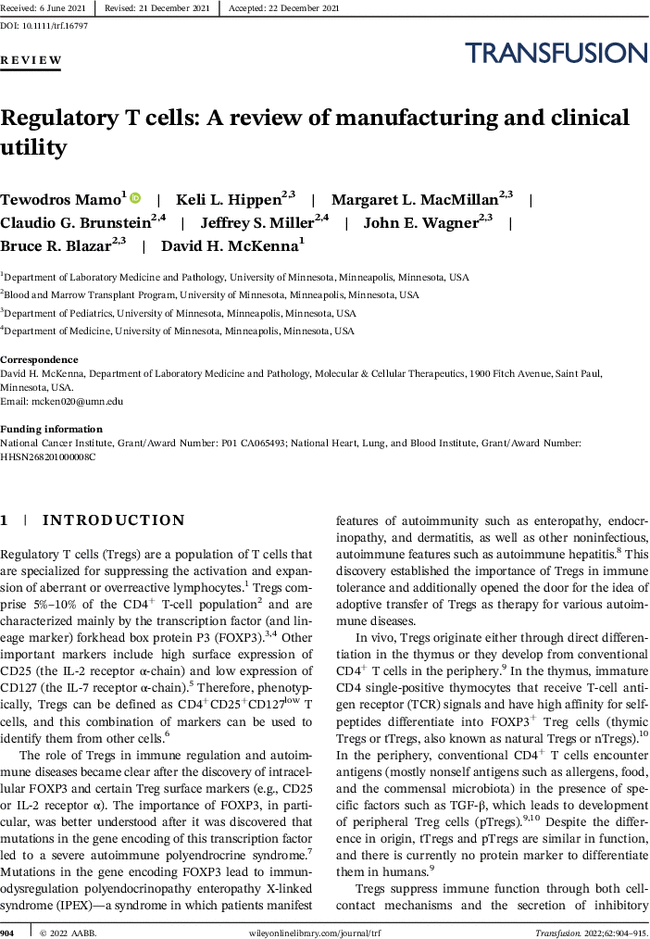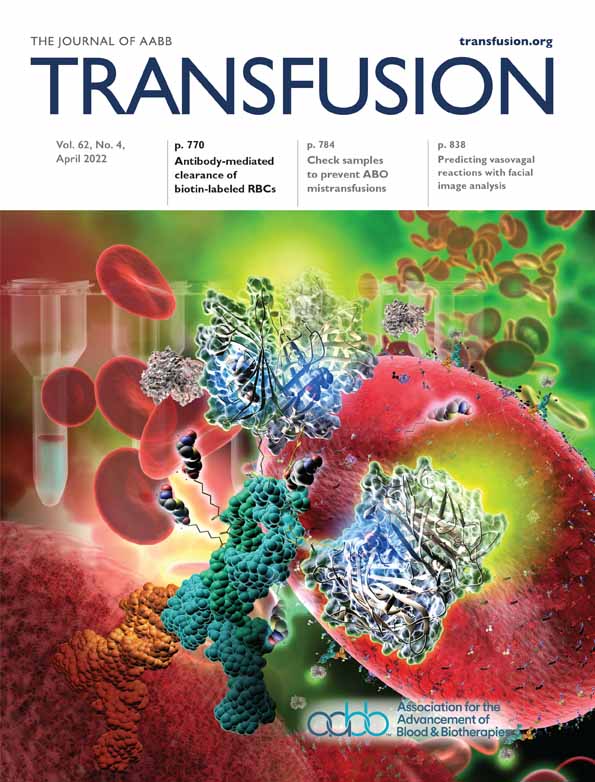Regulatory T cells: A review of manufacturing and clinical utility
Tewodros Mamo
Department of Laboratory Medicine and Pathology, University of Minnesota, Minneapolis, Minnesota, USA
Search for more papers by this authorKeli L. Hippen
Blood and Marrow Transplant Program, University of Minnesota, Minneapolis, Minnesota, USA
Department of Pediatrics, University of Minnesota, Minneapolis, Minnesota, USA
Search for more papers by this authorMargaret L. MacMillan
Blood and Marrow Transplant Program, University of Minnesota, Minneapolis, Minnesota, USA
Department of Pediatrics, University of Minnesota, Minneapolis, Minnesota, USA
Search for more papers by this authorClaudio G. Brunstein
Blood and Marrow Transplant Program, University of Minnesota, Minneapolis, Minnesota, USA
Department of Medicine, University of Minnesota, Minneapolis, Minnesota, USA
Search for more papers by this authorJeffrey S. Miller
Blood and Marrow Transplant Program, University of Minnesota, Minneapolis, Minnesota, USA
Department of Medicine, University of Minnesota, Minneapolis, Minnesota, USA
Search for more papers by this authorJohn E. Wagner
Blood and Marrow Transplant Program, University of Minnesota, Minneapolis, Minnesota, USA
Department of Pediatrics, University of Minnesota, Minneapolis, Minnesota, USA
Search for more papers by this authorBruce R. Blazar
Blood and Marrow Transplant Program, University of Minnesota, Minneapolis, Minnesota, USA
Department of Pediatrics, University of Minnesota, Minneapolis, Minnesota, USA
Search for more papers by this authorCorresponding Author
David H. McKenna
Department of Laboratory Medicine and Pathology, University of Minnesota, Minneapolis, Minnesota, USA
Correspondence
David H. McKenna, Department of Laboratory Medicine and Pathology, Molecular & Cellular Therapeutics, 1900 Fitch Avenue, Saint Paul, Minnesota, USA.
Email: [email protected]
Search for more papers by this authorTewodros Mamo
Department of Laboratory Medicine and Pathology, University of Minnesota, Minneapolis, Minnesota, USA
Search for more papers by this authorKeli L. Hippen
Blood and Marrow Transplant Program, University of Minnesota, Minneapolis, Minnesota, USA
Department of Pediatrics, University of Minnesota, Minneapolis, Minnesota, USA
Search for more papers by this authorMargaret L. MacMillan
Blood and Marrow Transplant Program, University of Minnesota, Minneapolis, Minnesota, USA
Department of Pediatrics, University of Minnesota, Minneapolis, Minnesota, USA
Search for more papers by this authorClaudio G. Brunstein
Blood and Marrow Transplant Program, University of Minnesota, Minneapolis, Minnesota, USA
Department of Medicine, University of Minnesota, Minneapolis, Minnesota, USA
Search for more papers by this authorJeffrey S. Miller
Blood and Marrow Transplant Program, University of Minnesota, Minneapolis, Minnesota, USA
Department of Medicine, University of Minnesota, Minneapolis, Minnesota, USA
Search for more papers by this authorJohn E. Wagner
Blood and Marrow Transplant Program, University of Minnesota, Minneapolis, Minnesota, USA
Department of Pediatrics, University of Minnesota, Minneapolis, Minnesota, USA
Search for more papers by this authorBruce R. Blazar
Blood and Marrow Transplant Program, University of Minnesota, Minneapolis, Minnesota, USA
Department of Pediatrics, University of Minnesota, Minneapolis, Minnesota, USA
Search for more papers by this authorCorresponding Author
David H. McKenna
Department of Laboratory Medicine and Pathology, University of Minnesota, Minneapolis, Minnesota, USA
Correspondence
David H. McKenna, Department of Laboratory Medicine and Pathology, Molecular & Cellular Therapeutics, 1900 Fitch Avenue, Saint Paul, Minnesota, USA.
Email: [email protected]
Search for more papers by this authorFunding information: National Cancer Institute, Grant/Award Number: P01 CA065493; National Heart, Lung, and Blood Institute, Grant/Award Number: HHSN268201000008C

CONFLICT OF INTEREST
BRB receives remuneration as an advisor to Magenta Therapeutics and Blue Rock Therapeutics; Research funding from BlueRock Therapeutics, Rheos Medicines, Equilibre, Carisma, and is a co-founder of Tmunity Therapeutics. CGB and JEW received research funding from BlueRock Therapeutics. TM, KLH, MLM, JSM, and DHM have disclosed no conflicts of interest. The authors alone are responsible for the content and writing of the article.
REFERENCES
- 1Sakaguchi S, Yamaguchi T, Nomura T, Ono M. Regulatory T cells and immune tolerance. Cell. 2008; 133: 775–87.
- 2Itoh M, Takahashi T, Sakaguchi N, Kuniyasu Y, Shimizu J, Otsuka F, et al. Thymus and autoimmunity: production of CD25+CD4+ naturally anergic and suppressive T cells as a key function of the thymus in maintaining immunologic self-tolerance. J Immunol. 1999; 162: 5317–26.
- 3Fontenot JD, Gavin MA, Rudensky AY. Foxp3 programs the development and function of CD4+CD25+ regulatory T cells. Nat Immunol. 2003; 4: 330–6.
- 4Hori S, Nomura T, Sakaguchi S. Control of regulatory T cell development by the transcription factor Foxp3. Science. 2003; 299: 1057–61.
- 5Liu W, Putnam AL, Xu-Yu Z, Szot GL, Lee MR, Zhu S, et al. CD127 expression inversely correlates with FoxP3 and suppressive function of human CD4+ T reg cells. J Exp Med. 2006; 203: 1701–11.
- 6Ferreira LMR, Muller YD, Bluestone JA, Tang Q. Next-generation regulatory T cell therapy. Nat Rev Drug Discov. 2019; 18: 749–69.
- 7Husebye ES, Anderson MS, Kampe O. Autoimmune Polyendocrine Syndromes. N Engl J Med. 2018; 378: 1132–41.
- 8Bennett CL, Christie J, Ramsdell F, Brunkow ME, Ferguson PJ, Whitesell L, et al. The immune dysregulation, polyendocrinopathy, enteropathy, X-linked syndrome (IPEX) is caused by mutations of FOXP3. Nat Genet. 2001; 27: 20–1.
- 9Dominguez-Villar M, Hafler DA. Regulatory T cells in autoimmune disease. Nat Immunol. 2018; 19: 665–73.
- 10Josefowicz SZ, Lu LF, Rudensky AY. Regulatory T cells: mechanisms of differentiation and function. Annu Rev Immunol. 2012; 30: 531–64.
- 11Raffin C, Vo LT, Bluestone JA. Treg cell-based therapies: challenges and perspectives. Nat Rev Immunol. 2020; 20: 158–72.
- 12Bluestone JA, Tang Q. Treg cells-the next frontier of cell therapy. Science. 2018; 362: 154–5.
- 13Zeiser R, Blazar BR. Acute graft-versus-host disease - biologic process, prevention, and therapy. N Engl J Med. 2017; 377: 2167–79.
- 14Blazar BR, MacDonald KPA, Hill GR. Immune regulatory cell infusion for graft-versus-host disease prevention and therapy. Blood. 2018; 131: 2651–60.
- 15Zwang NA, Leventhal JR. Cell therapy in kidney transplantation: focus on regulatory T cells. J Am Soc Nephrol. 2017; 28: 1960–72.
- 16Riley JL, June CH, Blazar BR. Human T regulatory cell therapy: take a billion or so and call me in the morning. Immunity. 2009; 30: 656–65.
- 17MacMillan ML, Hippen KL, McKenna DH, Kadidlo D, Sumstad D, DeFor TE, et al. First-in-human phase 1 trial of induced regulatory T cells for graft-versus-host disease prophylaxis in HLA-matched siblings. Blood Adv. 2021; 5: 1425–36.
- 18Mathew JM, Voss J, LeFever A, Konieczna I, Stratton C, He J, et al. A phase I clinical trial with ex vivo expanded recipient regulatory T cells in living donor kidney transplants. Sci Rep. 2018; 8: 7428.
- 19Chandran S, Tang Q, Sarwal M, Laszik ZG, Putnam AL, Lee K, et al. Polyclonal regulatory T cell therapy for control of inflammation in kidney transplants. Am J Transplant. 2017; 17: 2945–54.
- 20Todo S, Yamashita K, Goto R, Zaitsu M, Nagatsu A, Oura T, et al. A pilot study of operational tolerance with a regulatory T-cell-based cell therapy in living donor liver transplantation. Hepatology. 2016; 64: 632–43.
- 21Safinia N, Vaikunthanathan T, Fraser H, Thirkell S, Lowe K, Blackmore L, et al. Successful expansion of functional and stable regulatory T cells for immunotherapy in liver transplantation. Oncotarget. 2016; 7: 7563–77.
- 22Theil A, Tuve S, Oelschlagel U, Maiwald A, Dohler D, Ossmann D, et al. Adoptive transfer of allogeneic regulatory T cells into patients with chronic graft-versus-host disease. Cytotherapy. 2015; 17: 473–86.
- 23Bluestone JA, Buckner JH, Fitch M, Gitelman SE, Gupta S, Hellerstein MK, et al. Type 1 diabetes immunotherapy using polyclonal regulatory T cells. Sci Transl Med. 2015; 7:315ra189.
- 24Marek-Trzonkowska N, Mysliwiec M, Dobyszuk A, Grabowska M, Techmanska I, Juscinska J, et al. Administration of CD4+CD25highCD127- regulatory T cells preserves beta-cell function in type 1 diabetes in children. Diabetes Care. 2012; 35: 1817–20.
- 25Kellner JN, Delemarre EM, Yvon E, Nierkens S, Boelens JJ, McNiece I, et al. Third party, umbilical cord blood derived regulatory T-cells for prevention of graft versus host disease in allogeneic hematopoietic stem cell transplantation: feasibility, safety and immune reconstitution. Oncotarget. 2018; 9:35611–22.
10.18632/oncotarget.26242 Google Scholar
- 26Brunstein CG, Miller JS, McKenna DH, Hippen KL, DeFor TE, Sumstad D, et al. Umbilical cord blood-derived T regulatory cells to prevent GVHD: kinetics, toxicity profile, and clinical effect. Blood. 2016; 127: 1044–51.
- 27Brunstein CG, Miller JS, Cao Q, McKenna DH, Hippen KL, Curtsinger J, et al. Infusion of ex vivo expanded T regulatory cells in adults transplanted with umbilical cord blood: safety profile and detection kinetics. Blood. 2011; 117: 1061–70.
- 28Pahwa R, Jaggaiahgari S, Pahwa S, Inverardi L, Tzakis A, Ricordi C. Isolation and expansion of human natural T regulatory cells for cellular therapy. J Immunol Methods. 2010; 363: 67–79.
- 29Chwojnicki K, Iwaszkiewicz-Grzes D, Jankowska A, Zielinski M, Lowiec P, Gliwinski M, et al. Administration of CD4(+)CD25(high)CD127(−)FoxP3(+) regulatory T cells for relapsing-remitting multiple sclerosis: a phase 1 study. BioDrugs. 2021; 35: 47–60.
- 30Sawitzki B, Harden PN, Reinke P, Moreau A, Hutchinson JA, Game DS, et al. Regulatory cell therapy in kidney transplantation (the ONE study): a harmonised design and analysis of seven non-randomised, single-arm, phase 1/2A trials. Lancet. 2020; 395: 1627–39.
- 31Roemhild A, Otto NM, Moll G, Abou-El-Enein M, Kaiser D, Bold G, et al. Regulatory T cells for minimising immune suppression in kidney transplantation: phase I/IIa clinical trial. BMJ. 2020; 371:m3734.
- 32Sanchez-Fueyo A, Whitehouse G, Grageda N, Cramp ME, Lim TY, Romano M, et al. Applicability, safety, and biological activity of regulatory T cell therapy in liver transplantation. Am J Transplant. 2020; 20: 1125–36.
- 33Trzonkowski P, Bieniaszewska M, Juscinska J, Dobyszuk A, Krzystyniak A, Marek N, et al. First-in-man clinical results of the treatment of patients with graft versus host disease with human ex vivo expanded CD4+CD25+CD127- T regulatory cells. Clin Immunol. 2009; 133: 22–6.
- 34Dong S, Hiam-Galvez KJ, Mowery CT, Herold KC, Gitelman SE, Esensten JH, et al. The effect of low-dose IL-2 and Treg adoptive cell therapy in patients with type 1 diabetes. JCI Insight. 2021; 6(18):e147474.
- 35Marek-Trzonkowska N, Mysliwiec M, Iwaszkiewicz-Grzes D, Gliwinski M, Derkowska I, Zalinska M, et al. Factors affecting long-term efficacy of T regulatory cell-based therapy in type 1 diabetes. J Transl Med. 2016; 14: 332.
- 36Dijke IE, Hoeppli RE, Ellis T, Pearcey J, Huang Q, McMurchy AN, et al. Discarded human thymus is a novel source of stable and Long-lived therapeutic regulatory T cells. Am J Transplant. 2016; 16: 58–71.
- 37MacDonald KN, Ivison S, Hippen KL, Hoeppli RE, Hall M, Zheng G, et al. Cryopreservation timing is a critical process parameter in a thymic regulatory T-cell therapy manufacturing protocol. Cytotherapy. 2019; 21: 1216–33.
- 38Dawson NAJ, Levings MK. Antigen-specific regulatory T cells: are police CARs the answer? Transl Res. 2017; 187: 53–8.
- 39Rosado-Sanchez I, Levings MK. Building a CAR-Treg: going from the basic to the luxury model. Cell Immunol. 2020; 358:104220.
- 40Elinav E, Adam N, Waks T, Eshhar Z. Amelioration of colitis by genetically engineered murine regulatory T cells redirected by antigen-specific chimeric receptor. Gastroenterology. 2009; 136: 1721–31.
- 41Noyan F, Zimmermann K, Hardtke-Wolenski M, Knoefel A, Schulde E, Geffers R, et al. Prevention of allograft rejection by use of regulatory T cells with an MHC-specific chimeric antigen receptor. Am J Transplant. 2017; 17: 917–30.
- 42Tenspolde M, Zimmermann K, Weber LC, Hapke M, Lieber M, Dywicki J, et al. Regulatory T cells engineered with a novel insulin-specific chimeric antigen receptor as a candidate immunotherapy for type 1 diabetes. J Autoimmun. 2019; 103:102289.
- 43Boardman DA, Philippeos C, Fruhwirth GO, Ibrahim MA, Hannen RF, Cooper D, et al. Expression of a chimeric antigen receptor specific for donor HLA class I enhances the potency of human regulatory T cells in preventing human skin transplant rejection. Am J Transplant. 2017; 17: 931–43.
- 44MacDonald KG, Hoeppli RE, Huang Q, Gillies J, Luciani DS, Orban PC, et al. Alloantigen-specific regulatory T cells generated with a chimeric antigen receptor. J Clin Invest. 2016; 126: 1413–24.




